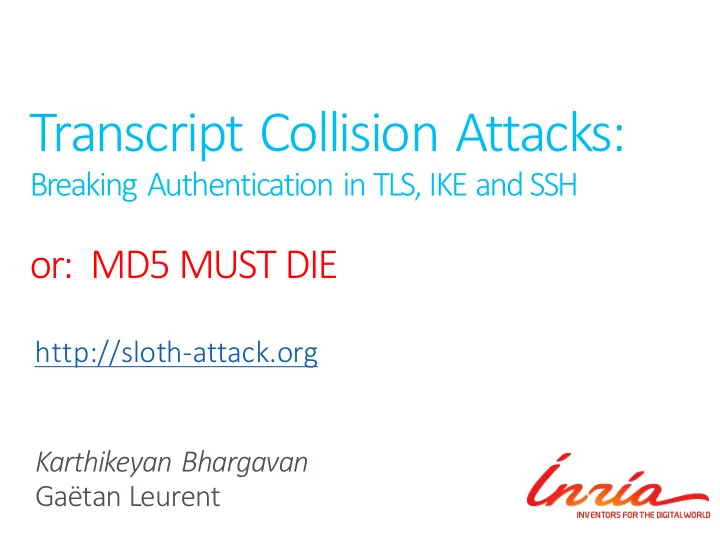

Transcript Collision Attacks: Breaking Authentication in TLS, IKE and SSH or: MD5 MUST DIE http://sloth-attack.org Karthikeyan Bhargavan Gaëtan Leurent
Crypto protocols and applications evolve Agility: graceful transition from old to new What can go wrong? • Downgrade attacks: POODLE, LOGJAM, SL SLOTH
Authenticated DH with Negotiation Version/Group/Cip her Parameters Signed Transcript
What Transcript to Sign? • Sign the full message trace – sign ( sk B , hash ( m 1 | m 2 )) – Example : TLS 1.3, SSH-2, TLS 1.2 client auth • Sign your ephemerals, MAC the transcript – sign ( sk B , hash ( nonce A | nonce B | g | p | g y )) – Example : TLS 1.2 server auth • Sign your own messages and MACed identity – sign ( sk A , hash ( m 1 | mac (k,A))) – sign ( sk B , hash ( m 2 | mac (k,B))) – Example: IKEv2 initiator, responder, EAP auth
Using Weak Hash Functions • Sign the full transcript – sign ( sk B , hash ( m 1 | m 2 )) – Example : TLS 1.3, SSH-2, TLS 1.2 client auth • How weak can the hash function be? – do we need collision resistance? – do we only need 2 nd preimage resistance? – Is it still safe to use MD5, SHA-1 in TLS, IKE, SSH? – Disagreement : cryptographers vs. practitioners (see Schneier vs. Hoffman, RFC4270)
SLOTH: Transcript Collision Attacks Man-in-the-Middle : network attacker/malicious server Parameter Downgrade Server Client Impersonation Impersonation
Computing a Transcript Collision hash ( m 1 | m’ 2 ) = hash ( m’ 1 | m 2 ) • We need to compute a collision, not a preimage – Attacker controls parts of both transcripts – If we know the black bits, can we compute the red bits? – This is usually called a generic collision • If we’re lucky, we can set up a shortcut collision – Common-prefix : collision after a shared transcript prefix – Chosen-prefix: collision after attacker-controlled prefixes
Primer on Hash Collision Complexity • MD5: known attack complexities – MD5 second preimage 2 128 hashes – MD5 generic collision: 2 64 hashes (birthday) – MD5 chosen-prefix collision: 2 39 hashes (1 hour) – MD5 common-prefix collision: 2 16 hashes (seconds) • SHA1: estimated attack complexities – SHA1 second preimage 2 160 hashes 2 80 hashes – SHA1 generic collision: (birthday) 2 77 hashes (?) – SHA1 chosen-prefix collision:
Composite Hash Constructions • When used as transcript hash functions many constructions are not collision resistant – MD5 (x) | SHA1 (x) not much better than SHA1 – HMAC-MD5 (k,x) not much better than MD5 – HMAC-SHA256 (k,MD5(x)) not much better than MD5 – Truncated HMAC-SHA256 (k,x) to N bits not much better than a N bit hash function
Computing Transcript Collisions A MitM B hash hash len 1 len 1 ’ m 1 m 1’ g x g x’ params A params’ A len 2 len 2 ’ m 2 m 2’ g y g y’ params B params’ B
Generic Transcript Collisions A MitM B hash hash Try random nonces len 1 len 1 ’ len 1 ’ until collision len 1 ’ g x g x’ g x’ g x’ nonce A nonce 1 nonce 2 nonce N len 2 len 2 ’ len 2 ’ len 2 ’ N = 2 | hash |/2 g static g y’ g y’ g y’ MD5: 2 64 Predictable: nonce A nonce 1 SHA-1: 2 80 Static DH key, nonce 2 nonce N HMAC/96: 2 48 no fresh nonce
Chosen-Prefix Transcript Collisions A MitM B len 1 m 1 g x blob A len 2 m 2 g y Known length, blob B ephemeral DH key, arbitrary BLOB
A MitM B hash hash len 1 len 1 ’ m 1 m 1’ g x g x’ blob A 00000000 len 2 ’ 00000000 blob A ’ Find Chosen-Prefix g y’ 00000000 Collision C 1 , C 2 C 1 C 2 len 2 len 2 N = 2 CPC ( hash ) blob B ’ m 2’ m 2 MD5: 2 39 g y g y SHA-1: 2 77 Merkle-Damgard blob B blob B HMAC/96: n/a hash extension
SLOTH: Attacking TLS 1.2 Client Auth • TLS 1.2 upgraded hash functions used in TLS – SHA-256 for all handshake constructions – New signature algorithms extension: SHA-256/384/512 • TLS 1.2 added support for MD5-based signatures! – Even if the client and server prefer RSA-SHA256 , the connection can be downgraded to RSA-MD5! • Transcript collisions break TLS 1.2 client signatures – Chosen prefix collision attack using flexible formats – Demo: Takes 1 hour/connection on a 48-core workstation – Not very practical : connection must be live during attack
SLOTH: Attacking TLS Server Auth • TLS 1.2 server signatures are harder to break – Irony : the weakness that enables Logjam blocks SLOTH – Needs 2 X prior connections + 2 128-X hashes/connection – Not practical for academics, as far as we know • TLS 1.3 server signatures is potentially vulnerable – New : MD5, SHA-1 sigs now explicitly forbidden in TLS 1.3
Other SLOTH Vulnerabilities • Reduced security for TLS 1.*, IKEv1, IKEv2, SSH – Impersonation attack on TLS channel bindings – Exploit downgrades + transcript collisions – These are protocol flaws, not implementation bugs – Main mitigation is to disable weak hash functions
Final Thoughts • Legacy crypto is strangely hard to get rid of, but we have to keep trying to kill broken primitives (MD5 MUST DIE) • Key exchanges in Internet protocols do rely on collision resistance, question anyone who tells you otherwise! • Future : new downgrade resilient protocols, collision-resistant authentication mechanisms • More details, papers, demos are at: http://sloth-attack.org
Recommend
More recommend